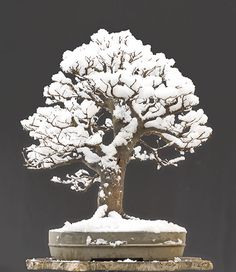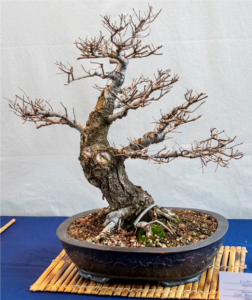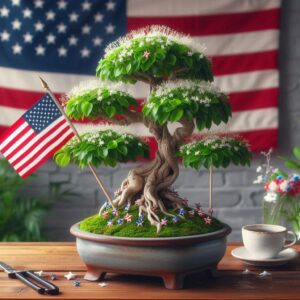
Moving Indoors
By Dan Kosta
Many of us grow indoor (tropical) bonsai as well as the more traditional temperate type of trees. These trees will need to be brought indoors soon. Ideally the trees should be indoors two weeks before the heating system is turned on but this is a difficult thing to work out.
By bringing the trees in early it reduces the “thermal shock” when they move from the outside to the inside. It is more of a shock if the tree is taken from a forty degree environment to a seventy degree one than it is if that tree were to go from fifty-five degrees to seventy degrees. The results of increased thermal shock can be increased leaf drop and sluggish recovery.
There are several factors to consider when moving tropical trees indoors. One of the most important is the availability of adequate light. Sunny, unobstructed windows are a good location. Be sure to keep the trees in the window, not beside it, and close to the glass. Experiments have shown that the light level is reduced by the square of the distance away from the glass. More simply this means that the light intensity decreases dramatically as the tree moves farther back from the window. A distance of 6 to 24 inches is probably about best.
If you do not have a good window location, or your trees outnumber your windows, or you simply don’t want the trees sitting in front of your windows, you may use artificial lighting to fulfill their needs. The most common is fluorescent lighting. Regular cool white tubes are fine for your indoor trees. Once again you will need to keep the trees close to the lights. Since fluorescent tubes are cool to the touch the foliage can be within two inches of the tubes without burning it. Since the strength of the light is relatively low the lights need to be run for fourteen to sixteen hours each day. A timer is a good idea to make sure the lights turn on and off at the appropriate intervals.
Metal halide lights are sometimes used for indoor plants. These stronger lights can produce very good results for your trees. You will need to remember, however, that these lights produce heat and so they will need to be farther from your trees. These lights also need special ballasts and fixtures.
Another important factor is humidity. Unfortunately our centrally heated homes can make the Sahara seem humid. This results in the trees drying out quickly can be a factor in leaf drop and poor growth. A humidifier placed near the trees will go a long way toward solving this problem. An alternative is a humidity tray. This is a shallow dish filled with gravel. Add water to the tray until the water level is just below the surface of the gravel. The water should not touch the bottom of the pot. Check these trays frequently and replenish the water as needed.
Temperature can also play a role in the health and vigor of the trees. While most tropicals are happy from sixty to seventy-five there are a few that would prefer cooler temperatures. Chinese elm, boxwood, pomegranite, olive, and crepe myrtle would do well at forty to fifty-five degrees.
A few other things to consider would be drafts, ease of watering in a particular location, and how often you are in the area where the trees will reside. If you can satisfy the requirements of your trees, and be watchful of their needs, you will be able to maintain beautiful bonsai indoors all winter long.



